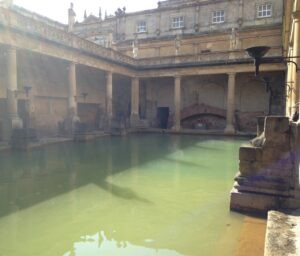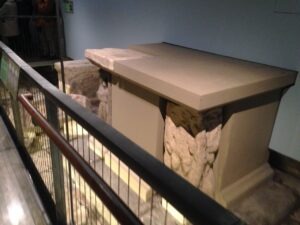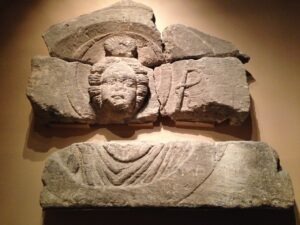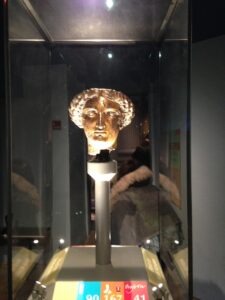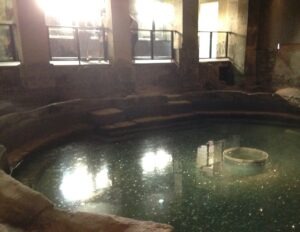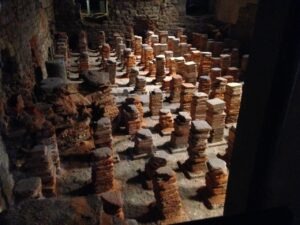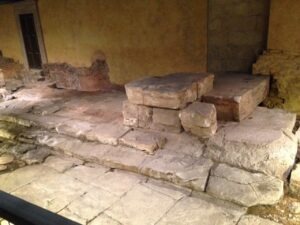The Roman Baths, which give the City of Bath, Somerset its name, are a profound window into the world of Roman Britain. In ancient times, this site was a popular spa built around hot springs and dedicated to the goddess Sulis Minerva. People would come here for bathing, relaxation, and the hope of healing.
The hot springs in modern day Bath were already considered sacred long before the Romans invaded Britain in AD 43. It was at this site that the local tribe of Celts, known as the Dobunni, worshipped Sulis – the goddess of healing, fertility, and sacred water. According to legend, an exiled prince named Bladud first discovered the power of Sulis’ springs in 863 AD. He had been banished from court after contracting leprosy, so he roamed the land as a swineherd. In the area of modern day Bath, his pigs wallowed in the mud near the spring. Afterwards, Bladud noticed how the skin of these pigs was remarkably healthy. He then decided to bath in the mud himself and was miraculously cured of his disease. Bladud returned home to become king and built a temple to Sulis at the site.
After the Romans took control, they built a spa around the springs and the area grew into the city of Aquae Sulis (The Waters of Sulis). Beyond the practical and social aspects of the baths, the city became a major pilgrimage site due to the supposed healing properties of the water. As part of the takeover process, the Romans merged the Celtic goddess Sulis into their own belief system. They identified Sulis with Minerva, the Roman goddess of wisdom and commerce. Thus, the deity of the hot springs became known as Sulis Minerva, and a temple devoted to her was part of the bath complex. This merging of gods is referred to as syncretism and was a common practice of the Romans.
The bath complex would have consisted of multiple areas. The bathhouse itself contained the Great Bath Hall as well as various rooms for changing, sweating, relaxing, and other spa activities. There was a large courtyard that featured an altar for animal sacrifices. On either side of the courtyard was a temple, one dedicated to Luna (the moon goddess) and one for Sol (the sun god). At the center of the courtyard was the Temple of Sulis Minerva.
The remains of the central temple show that a large face was carved above the entrance (on the pediment). Many believe this is a representation of the Gorgon Medusa. This would make sense given that, in classical mythology, Minerva was the one who cursed Medusa with snake hair and a petrifying gaze. Minerva also guided the hero Perseus in cutting off Medusa’s head. At the end of his quest, Perseus gave the head to Minerva, who in turn placed it on her shield. Interestingly, the image of Medusa above the temple appears to be male, given that it has a beard!
Within the Temple of Sulis Minerva stood a golden statue of the goddess, slightly larger than life size. Only the priests would have been permitted to enter into this sacred space. Today, just the head remains, though it’s missing its Corinthian helmet. This artifact is on display at the museum.
Since the spring water seemed to miraculously emerge from the ground, it was believed to be a link to the underworld and the gods. People would frequently throw objects of value into the spring, such as coins and jewelry, in the hopes that these sacrifices would earn them blessings. People would also write requests on small sheets of lead or pewter, roll them up, and drop them in. These notes were often asking the goddess to punish some wrongdoer, such as a thief. Given this, these little rolls of metal are known as curse tablets. You can see a variety of objects found in the spring on display at the museum.
When the Romans left Britain in the late 4th century, the bath complex was no longer maintained and the buildings deteriorated. Eventually, new structures were built over the ruins of the Roman ones and people forgot about the grandeur of what once had been there. Then, in 1878, there was a major discovery. Major Charles Davis, the city’s surveyor and architect, was investigating a leak in the King’s Bath (a bathing room from the medieval period) when he came upon some Roman artifacts. This led to the discovery of the Great Bath Hall and a major archeological effort to unearth the Roman Baths.
Today, the City of Bath is a UNESCO World Heritage Site. Admission into the Roman Baths allows you to explore the various areas of the excavated bath complex. Through the Victorian entrance hall, you’ll find yourself on the terrace overlooking the Great Bath. You’ll descend to lower floors to explore the different rooms, as the site sits below street level. Numerous objects discovered at the site are on display. There’s also a gift shop and restaurant. Refer to the official site for visitor info.
When visiting the Roman Baths, you quite literally get to walk in the footsteps of the ancient Romans. Exploring the complex and learning about their customs and spiritual beliefs is a truly powerful experience. Perhaps there really is something magical about this place.
Location
Roman Baths
Abbey Church Yard
Bath
BA1 1LZ
UK
Official Site: romanbaths.co.uk
Sources
“BBC – Legacies – Immigration and Emigration – England – Somerset – Roman Bath’s Celtic acquisition.” BBC. https://www.bbc.co.uk/legacies/immig_emig/england/somerset/index.shtml.
“Fun Facts.” Roman Baths. https://www.romanbaths.co.uk/fun-facts.
Joanna (The Baths Bloggers). “Found It! – Pop Quiz!” Beyond the Baths, October 12, 2010. http://bathsbloggers.blogspot.com/2010/10/found-it-pop-quiz.html.
Linda and Dr. Dick Buscher. “In photos: The ancient Roman baths of Bath, England.” Live Science, September 27, 2022. https://www.livescience.com/29635-ancient-roman-baths-england.html.
Macquire, Kelly. “Medusa.” World History Encyclopedia. Last modified June 14, 2022. https://www.worldhistory.org/Medusa/.
Marcussen, Wanda. “The Roman Baths in Bath- A Deep Dive into Britain’s Ancient History.” World History Encyclopedia. Last modified August 23, 2019. https://www.worldhistory.org/article/1427/the-roman-baths-in-bath–a-deep-dive-into-britains/.
“Minerva’s Head.” Roman Baths. https://www.romanbaths.co.uk/minervas-head.
“Religion in Roman Britain.” English Heritage. https://www.english-heritage.org.uk/learn/story-of-england/romans/religion/.
“The Rise and Fall of the Roman Baths.” BBC Rewind. https://canvas-story.bbcrewind.co.uk/sites/rise-and-fall-of-roman-baths/.
“Soak Up Some History – What Does Water Mean to Bath?” Visit Bath. March 19, 2021. https://visitbath.co.uk/blog/read/2021/03/soak-up-some-history-what-does-water-mean-to-bath-b80.
“Walkthrough.” Roman Baths. https://www.romanbaths.co.uk/walkthrough.
Written by A. P. Sylvia

